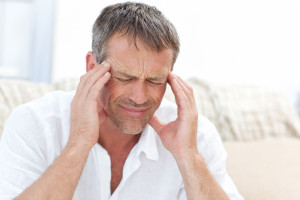Introduction
About 1 to 2 per 1000 people in the general population suffer from a cluster headache.
As the pain is so intense, the physician sees these patients relatively frequently. Men outnumber women with this type of headache by a margin of 6 to 1. It occurs in patients aged in their 20’s to high 50’s.
The name derives from the fact that there are clusters of frequent headaches that occur every few hours, last only between 15 minutes to 3 hours and after a period of several weeks of these headaches they disappear suddenly for several months or 1 or 2 years. Unfortunately the cycle repeats itself in the same manner. There is a genetic factor as relatives of cluster headache patients are about 13-fold more likely to also develop these headaches.
It appears that abnormal parasympathetic and sympathetic nerve fibers connected with the trigeminal nerve and ophthalmic nerve and attached to the carotid artery cause cluster headaches (Ref. 1, p. 2069).
According to Dr. Lichten (Ref. 11) there is a strong correlation of cluster headaches with low testosterone levels. This makes it very important in any man who suffers from cluster headaches to do blood tests for bioavailable testosterone.
Cluster headache symptoms
The headache is centered to one side of the head and occurs in the eye socket, above the eye or in the temporal area as a stinging, piercing pain.
It may be triggered by alcohol consumption or by nitrates (found in red looking hamburger meat, in cheeses, sausages etc.). Associated with the cluster headaches and on the same side as the headaches the following other signs are found: bloodshot eyes, nasal stuffiness, tearing of the eye on the affected side, a runny nose, eye lid swelling and/or drooping and a pin-sized pupil only on the affected side with a normal pupil size on the other eye. In 10% of patients the headache remains there all the time, which can be very devastating.
Treatment
During an acute bout breathing of pure oxygen (100%) by face mask is very beneficial. Many patients respond to ergotamine, which is given sublingually. Sumatriptan given subcutaneously is also often effective. However, both of these latter substances are constricting blood vessels and cannot be given to patients who are at risk for a heart attack. Verapamil and lithium have both been shown to help prevent the next cluster headache and are therefore useful for prevention. Other more toxic drugs are also used, but side-effects are always the trade-off. Corticosteroids, although often empirically used, have not been shown to be effective in trials (Ref. 1, p. 2069).
The newest successful treatment has been developed by Dr. Lichten (Ref.11) by giving male patients with cluster headaches testosterone pellets every month under the skin in the buttock region. This will keep testosterone levels less fluctuating and keep them above the threshold below which cluster headaches are triggered. Natural testosterone also has a very beneficial effect of preventing heart attacks, Alzheimer’s disease, osteoporosis, fatigue, diabetes and weight gain. Other applications of testosterone are also useful, but not as successful as the subcutaneous testosterone pellets.
References:
1. Goldman: Cecil Textbook of Medicine, 21st ed.,2000, W. B. Saunders Company
2. B. Sears: “The top 100 zone foods”. Regan Books, Harper Collins, 2001.
3. The Merck Manual, 7th edition, by M. H. Beers et al., Whitehouse Station, N.J., 1999. Chapter 176.
4. Noble: Textbook of Primary Care Medicine, 3rd ed.,2001, Mosby, Inc.
5. Goroll: Primary Care Medicine, 4th ed.,2000, Lippincott Williams & Wilkins
6.Rosen: Emergency Medicine: Concepts and Clinical Practice, 4th ed., 1998, Mosby-Year Book, Inc.
7. Ruddy: Kelley’s Textbook of Rheumatology, 6th ed.,2001, W. B. Saunders Company
8. Ferri: Ferri’s Clinical Advisor: Instant Diagnosis and Treatment, 2004 ed., Copyright © 2004 Mosby, Inc.
9. Rakel: Conn’s Current Therapy 2004, 56th ed., Copyright © 2004 Elsevier
10. Suzanne Somers: “Breakthrough” Eight Steps to Wellness– Life-altering Secrets from Today’s Cutting-edge Doctors”, Crown Publishers, 2008
11. Dr. Edward M. Lichten: “Textbook of bio-identical hormones”; 2007, Fondation for Anti-aging Research, page 171 and 172.







